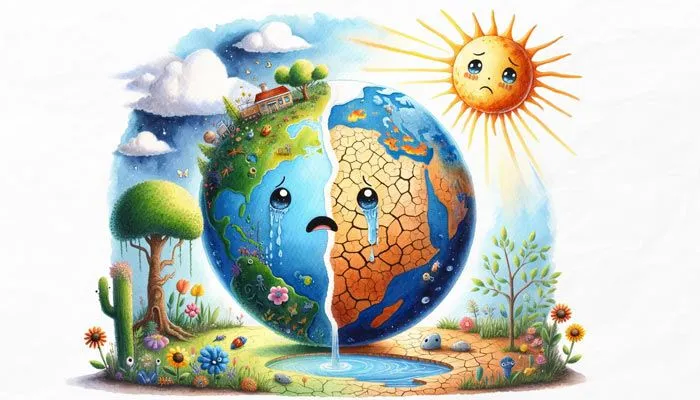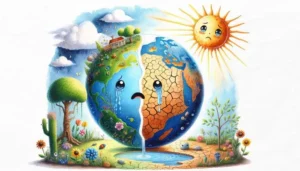
Environment alludes to the drawn out examples and midpoints of climate in a specific district overstretched periods, regularly 30 years or more. It includes not simply the normal circumstances, like tempreture and precipitation, yet in addition the scope of changeability and the recurrence of outrageous occasions.

Understanding environment is fundamental for various bits of human existence, from agribusiness and water assets for flourishing and foundation coordinating. This article investigates the bits of environment, the parts influencing it, and its importance.
TABLE OF CONTENT
-
Parts of Environment
-
A few variables decide the environment of a district, going from geological to air conditions:
-
The Significance of Environment
-
Temperature
-
Precipitation
-
Environment
-
Interconnectedness and Suggestions
-
End
Parts of Environment
1. Temperature: One of the most central parts of environment, temperature influences each aspect of the normal world. Normal temperatures, occasional varieties, and outrageous ups and downs all add to the general environment of a locale.
2. Precipitation: This incorporates all types of water, fluid or strong, that tumbles from the air and arrives at the ground. The sum, recurrence, and kind of precipitation (downpour, snow, slush, hail) are significant for characterizing a district’s environment.
3. Moistness: This actions how much water fume in the air. Moistness impacts both atmosphere earth conditions and environment, influencing temperature and precipitation.
4. Wind: Wind designs, including their bearing and speed, are impacted by the World’s revolution, geography, and temperature contrasts. Wind assumes a critical part in climate frameworks and long haul environment designs.
5. Sun oriented Radiation: how much sun powered energy got by a locale influences its temperature and climate frameworks. Varieties in sunlight based radiation because of the World’s slant and circle lead to occasional changes in environment.
6. Barometrical Tension: Strain frameworks, for example, high and low-pressure regions, impact climate and environment by influencing wind and precipitation designs.
Factors Impacting Environment
A few variables decide the environment of a district, going from geological to air conditions:
1. Scope: Scope fundamentally influences environment by deciding the point and force of daylight got. Locales close to the equator experience hotter environments, while those nearer to the posts are colder.
2. Height: Higher elevations by and large have cooler temperatures. Precipitous districts can make shifted climatic zones inside a somewhat little geographic region.
3. Closeness to Water Bodies: Enormous waterways, like seas and oceans , moderate the environment of neighboring regions. Waterfront districts frequently have milder environments than inland regions at comparable scopes.
4. Sea Flows: These enormous scope water developments convey heat all over the world, impacting beach front environments. Warm flows can raise temperatures, while cold flows can bring down them.
5. Geography: The actual elements of the scene, including mountains, valleys, and fields, can influence wind examples, precipitation, and temperature dispersion.
6. Vegetation: Plant cover impacts environment through processes like happening and albedo (reflectivity). Forested regions will generally be cooler and more sticky than deserts.
7. Human Exercises: Urbanization, deforestation, and the consuming of petroleum products add to changes in environment by adjusting climatic piece and surface attributes.
Environment Order
Environments are ordered into different sorts in light of their drawn out weather conditions. The Koppen Environment Grouping is quite possibly of the most broadly utilized framework. It orders environments into five fundamental gatherings:
1. Tropical: Portrayed by high temperatures and critical precipitation over time. Models incorporate the Amazon Bowl and the Congo Bowl.
2. Dry: Locales with low precipitation, including deserts and steppes. Models are the Sahara Desert and the Incomparable Fields.
3. Calm: Regions with moderate temperatures and particular seasons. Models incorporate quite a bit of Europe and the eastern US.
4. Mainland: Locales with more outrageous temperature varieties among summer and winter. Models are tracked down in a lot of Russia and Canada.
5. Polar: Regions with freezing temperatures and low precipitation. Models incorporate Antarctica and the Cold.
The Significance of Environment
Environment significantly affects the common habitat and human social orders. A portion of its huge impacts include:
1. Agribusiness: Environment decides the sorts of harvests that can be developed, the developing season, and the efficiency of rural terrains.
2. Water Assets: Environment influences the accessibility and circulation of water, impacting all that from drinking water supplies to hydroelectric power.
3. Biodiversity: Various environments support various sorts of biological systems and species. Environmental change can prompt changes in territories and compromise biodiversity.
4. Human Wellbeing: Environment impacts the spread of infections, air quality, and intensity related diseases. Outrageous climate occasions, for example, heatwaves and storms, present direct dangers to human wellbeing.
5. Framework: Building and foundation configuration should consider nearby environment conditions to guarantee security and life span. For instance, streets and scaffolds in chilly environments should be worked to endure freeze-defrost cycles.
6. Economy: Environment influences financial exercises, including the explore industry, fishing, and energy creation. Adjusting to environmental change is fundamental for supportable financial turn of events.
Understanding environment includes concentrating on long haul weather conditions and the different elements that impact these examples. It is a vital part of arranging and dynamic in numerous areas of human existence, from horticulture to metropolitan turn of events. As environmental change turns into an undeniably major problem, fathoming environment elements is a higher priority than any time in recent memory for guaranteeing a manageable future
Temperature
– Estimation: Degrees Celsius (°C) or Fahrenheit (°F).
– Impacting Elements:
– Scope: Equator is hotter; shafts are cooler.
– Height: Higher elevations are cooler.
– Nearness to Water: Seaside regions have milder temperatures.
– Influences:
– Impacts photosynthesis, metabolic rates, species appropriation.
– Outrageous temperatures cause heatwaves or chilly fronts, influencing biological systems and human exercises.
Precipitation
– Types: Downpour, snow, slush, hail.
– Impacting Elements:
– Topographical Area: Central locales get more precipitation; polar districts get less.
– Geology: Mountains cause orographic lift, prompting precipitation.
– Occasional Varieties: Rainstorm seasons bring weighty precipitation; different locales experience occasional movements.
– Influences:
– Recharges freshwater assets, upholds plant development, keeps up with environments.
– Varieties can prompt dry spells or floods, influencing water accessibility and horticulture.
Environment
– Definition: Long haul normal of weather conditions (more than 30 years).
– Types: Tropical, calm, parched, polar.
– Influences:
– Decides vegetation and creature species, impacts horticulture, shapes human settlements.
– Environmental change prompts serious climate occasions, rising ocean levels, and biological system shifts.
Interconnectedness and Suggestions
– Interconnected Nature: Changes in temperature influence precipitation examples and environment.
– Effects of Environmental Change:
– Adjusts atmospheric conditions, prompting more serious tempests or dry spells.
– Influences water accessibility, food security, and biodiversity.
– Alleviation and Variation:
– Decrease ozone depleting substance outflows.
– Advance economical land use rehearses.
– Improve people group and biological system flexibility.
End
Temperature, precipitation, and climate are chief pieces of the environment, each expecting a basic part in framing the ordinary world and influencing human activities. Temperature picks warm circumstances, influencing typical cycles and species developments.Precipitation gives huge water resources, supporting plant progress and staying aware of conditions.climate, the long typical of weather patterns, coordinates the sorts of vegetation and animal species that can prosper in a district, affecting cultivation, and framing human settlements.
The interconnected thought of these parts infers that changes of one can generally influence the others. For instance, expanding overall temperatures due to ecological change can alter precipitation plans, inciting more exceptional environment events, similar to storms or dry seasons, and moving natural frameworks. These upgrades present central difficulties to water straightforwardness, food security, and biodiversity, including the key for proactive measures to decrease and change in accordance with their possessions.
Figuring out the complexities and interrelationships of temperature, precipitation, and climate is key for making useful strategies for thinking to address normal challenges. This integrates diminishing ozone exhausting substance transmissions, progressing plausible land use practices, and updating the strength of organizations and conditions to climatic assortments. By empowering an exhaustive understanding and taking proactive steps, we can all the more promptly safeguard the delicate balance of our ongoing situation and assurance a plausible future for all.







